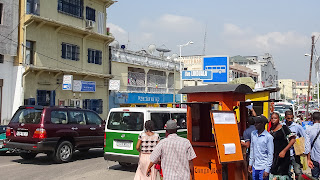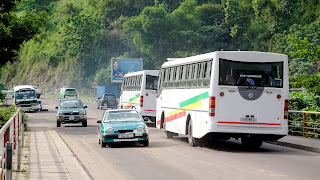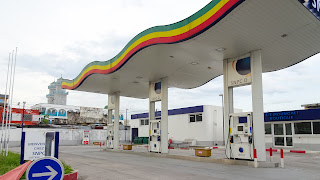Republic Congo - And then I was in the Congo...

"I will never go to the Congo - for sure!" - that's what I remember saying back in primary school in geography lessons. It's now a long time since then and a lot has changed in the Congo itself. Back then there was war and the only thing we knew up until the internet appeared was, that there was... war.
Now I'm here. I have a few days in the Republic of Congo and then continue having a few days in the Democratic Republic of Congo. These are two different countries and very different in appearance.
From the Congo on the left to the Congo on the right is only 500 meters across the river. It sounds so easy and obvious how to get to the Democratic Republic of Congo from here, but I heard a lot of stories that it is a fuss.
A few preparations and preliminary information to cross the river were important, especially in this corner of the world.
What is required is the visa, ideally a fixer, a bit of cash and not too much rain (because the canoes don't run in the rain). The journey costs in total about 20000 CFA which is about 30 Euros.
Map of Brazzaville and Djoue
A few preparations and preliminary information to cross the river were important, especially in this corner of the world.
What do I have to do to get from the Republic Congo to the Democratic Republic Congo?
The Visa procedures were confusing and needed a lot of effort, for both, the Republic of Congo (RC) and the Democratic Republic of Congo (DRC). But apart from the visa, the transport from one to the other Congo is indeed quite easy once sitting in the vehicle, the canoe.What is required is the visa, ideally a fixer, a bit of cash and not too much rain (because the canoes don't run in the rain). The journey costs in total about 20000 CFA which is about 30 Euros.
First, visiting the capital Brazzaville!
Before attempting and see how it actually works to get from the Congo to the DRC in reality, I had two days to visit the capital "Brazzaville".Map of Brazzaville and Djoue
Day 1 - Arrival in the Republic of Congo
The flight from Angola to Brazzaville with TAAG was very pleasant and the flight was very short. Entry through immigration was no problem at all.I was quickly out of the airport and the helper from the hotel was already waiting for me with a sign and my name on it.
On the bottom side (in the picture) is the RC and on the top across the river, the Democratic Republic Congo (DRC).
The best exchange rate is in the airport... (true)
I wanted to change money at the airport because I was told that in Brazzaville there are few possibilities to change money. Surprisingly the exchange rate is for 1 Euro = 710 CFA which is high (good). The normal exchange rate for 1 Euro is 655 CFA.The hotel staff took me to the exchange office inside the airport and then by taxi to the hotel "Hoteliere de Moungali". The hotel has very good Wifi and A/C and breakfast is also good. The location was ideal in the center of Brazzaville.
My first impression of the Republic Congo
I found Brazzaville very pleasant and although it was an African capital with a lot of traffic, it was not too loud and the people on the street all seemed friendly.
After checking in and leaving my things at the hotel I took the first walk through the center of Brazzaville. It was already slowly getting dark.
Similar to almost every other African nation, the police are observing all the roads in the city center and being a white foreigner feels like blinking when walking down the road. But the police greeted me very when passing by, even though seeming to be a bit wondering what I'm up to.
Regarding the "restrictiveness of taking photographs" situation, I didn't want to find out here, so I was reluctant on taking images along the busy main road.
I walked around it and had a quick look inside, where one woman was praying.
There was the main street "Avenue de la Paix" which ends at the riverfront where the "Plateau" district began. I had enough time to simply walk leisurely.
At the front around the Plateau area are many restaurants and even a big shopping mall "Hypermarché Géant casino" with tables and chairs inside the supermarket. It's like "buy what you want and eat inside the supermarket", and it's normal there. And it even had free Wifi.
Africa definitely has arrived in the 21st century.
It's some kind of museum and in a safe area in the plateau district, just walking distance from the center.
After checking in and leaving my things at the hotel I took the first walk through the center of Brazzaville. It was already slowly getting dark.
Day 2 - Visit Brazzaville and the river currents "Les Rapids"
The hotel was situated on a side street not far from the main road where all of Brazzaville meets by foot to do business. Also, I realized that people here in Brazzaville are in a good "mood", with no grunting or floor-spitting when seeing white foreigners.Similar to almost every other African nation, the police are observing all the roads in the city center and being a white foreigner feels like blinking when walking down the road. But the police greeted me very when passing by, even though seeming to be a bit wondering what I'm up to.
Regarding the "restrictiveness of taking photographs" situation, I didn't want to find out here, so I was reluctant on taking images along the busy main road.
Along the way was the church "Basilique Sainte Anne"
The church was in a very nice area of the capital, right beside the "Avenue de la Paix". It's almost impossible to not spot it when being in Brazzaville as its a tall church. It was built during WW2.I walked around it and had a quick look inside, where one woman was praying.
The streets and the catering inside the supermarket at "Plateau"
Brazzaville kept me busy just by walking through the streets.There was the main street "Avenue de la Paix" which ends at the riverfront where the "Plateau" district began. I had enough time to simply walk leisurely.
At the front around the Plateau area are many restaurants and even a big shopping mall "Hypermarché Géant casino" with tables and chairs inside the supermarket. It's like "buy what you want and eat inside the supermarket", and it's normal there. And it even had free Wifi.
Africa definitely has arrived in the 21st century.
Memorial of "Pierre Savorgnan de Brazza"
They also didn't charge any entrance fee, I only needed to deposit the passport there, which I got back when I left.It's some kind of museum and in a safe area in the plateau district, just walking distance from the center.
The outside area was nice with a big statue and a monument of the book from mister Brazza (also known as Pierre Savorgnan de Brazza). Mister Brazza was the guy who freed many slaves in Congo.
Some say it is the National Museum, but the name "National Museum of Congo" is quite misleading. In fact, this elegant dome-shaped construction, made of white marble, is not a "Musée National", but a mausoleum of Brazza-guy.
Unfortunately, they didn't allow me to take many pictures of all the African art inside the mausoleum.
Some say it is the National Museum, but the name "National Museum of Congo" is quite misleading. In fact, this elegant dome-shaped construction, made of white marble, is not a "Musée National", but a mausoleum of Brazza-guy.
Unfortunately, they didn't allow me to take many pictures of all the African art inside the mausoleum.
The bridge along the "La Route De La Corniche"
After the mausoleum, I took a taxi to get to the Congo River and see "Les Rapides".The taxi drives along the corniche and crosses the huge bridge. It's not a bridge that crosses above water but leads cars above villages. The taxi driver explained:
A nice bridge with nice houses along the road, but I wondered why there are not many more cars on it. It was suspiciously empty on the road. Probably because everyone who uses it has to pay a road toll but nobody has the money to pay the toll?
There I expected to see some shore and then the river, but I was impressed to see that there is a quiet small village and a large open-air restaurant called "Les Rapides".
You see...?! there is no water below us. The bridge was built only three years ago in 2016 and it was built to relieve the area from traffic congestion.
A nice bridge with nice houses along the road, but I wondered why there are not many more cars on it. It was suspiciously empty on the road. Probably because everyone who uses it has to pay a road toll but nobody has the money to pay the toll?
River watching at "Les Rapides"
For 1000 CFA the taxi brought me from the mausoleum along the corniche to the "Les Rapides".There I expected to see some shore and then the river, but I was impressed to see that there is a quiet small village and a large open-air restaurant called "Les Rapides".
The restaurant is bordering the Congo river with only 1 meter space between, so it was like having a coffee inside the river.
With all the wars inside the DRC and the Ebola outbreaks, such a bridge would be a high risk for the safety of the Congo.
It's nice to have a rest in the restaurant and watch across the river towards the DRC. Outside the fence of the restaurants are the locals fishing and doing their laundry.
It was on private property but easily visible when walking from the Route du Djoue to "Les Rapides".
Their goal is to provide their part to save the planet.
The current here was massive for such a small river and it flushed further dirt and dust and trees into the Congo River.
But summarized, the river crossing sounds easy, as it's only around 300 meters to be crossed to get from RC to Congo Kinshasa (DRC). The total price for the whole journey was equivalent of 35 Euros and took around 2-3 hours (because of the heavy rain).
The river is huge, but ugly when considering the color.
It's brown water and it brings stuff from the very deep center of the jungles from the DRC. I would not be surprised to spot any dead bodies in there, which have been dropped in here from the conflict zones in the east of DRC.
The important natural border to the DRC
I can relate why the government of the Republic of Congo does not want to speed up the construction of the bridge towards the Democratic Republic of Congo (DRC). This river served as a natural border since... beginning of the two countries.With all the wars inside the DRC and the Ebola outbreaks, such a bridge would be a high risk for the safety of the Congo.
It's nice to have a rest in the restaurant and watch across the river towards the DRC. Outside the fence of the restaurants are the locals fishing and doing their laundry.
They collect old bottles and bottle caps and build Art
One of the best art exhibitions I've ever seen in Africa. When I passed by their house I was first a bit "shocked" when I realized there is this elephant in their garden.It was on private property but easily visible when walking from the Route du Djoue to "Les Rapides".
The small team there was collecting bottles, bottle caps, aluminum cans, and all kinds of other cans - all fished out by bare hands from the Congo River.
Their goal is to provide their part to save the planet.
The lookout on the powerful river "Djoue River"
After having the rest in the "Les Rapides" I walked along the road towards Djoue, as there was another bridge that connected above the Djoue River.The current here was massive for such a small river and it flushed further dirt and dust and trees into the Congo River.
Back to Brazzaville with a stop at the "Corniche"
By now it was already late in the afternoon.I took a taxi back to Brazzaville and plan my departure for tomorrow to the DRC. By today there is no rain yet but when observing the clouds, it looks like there might be heavy rain arriving this evening.
And once it rains in the Congo's it may last for several days!
I just hope tomorrow will be no rain so that I can go to the DRC without problems.
The most common vehicle to cross the river to the DRC is the canoe. I never ever immigrated to a country by canoe.
I just hope tomorrow will be no rain so that I can go to the DRC without problems.
Day 3 – With the canoe to the DRC
As of today, there is no bridge between RC and DRC yet. It is only in the planning stage so far. Until then, all people still have to canoe and cross the river to the other country.The most common vehicle to cross the river to the DRC is the canoe. I never ever immigrated to a country by canoe.
They plan to build a huge bridge between Brazzaville and Kinshasa and plans are already finalized, but until the bridge finally lets people cross countries it may take another couple of many-many years.
I wanted to leave the hotel this morning as early as possible and move on to the Democratic Republic of Congo because the departure area at the port can fill up real quick and become confusing.
I wanted to leave the hotel this morning as early as possible and move on to the Democratic Republic of Congo because the departure area at the port can fill up real quick and become confusing.
How to get from the Republic Congo to the DRC?
I did not find any up-to-date information or details on how to get from Brazzaville (RC) to Kinshasa (DRC). All I knew was that there is a boat, but no prices or timetables are available. Even the Hotels could not tell me the details.But summarized, the river crossing sounds easy, as it's only around 300 meters to be crossed to get from RC to Congo Kinshasa (DRC). The total price for the whole journey was equivalent of 35 Euros and took around 2-3 hours (because of the heavy rain).
It's a bit of a journey itself, the river and border crossing and that's why I put it in a separate post.
















































































Post a Comment